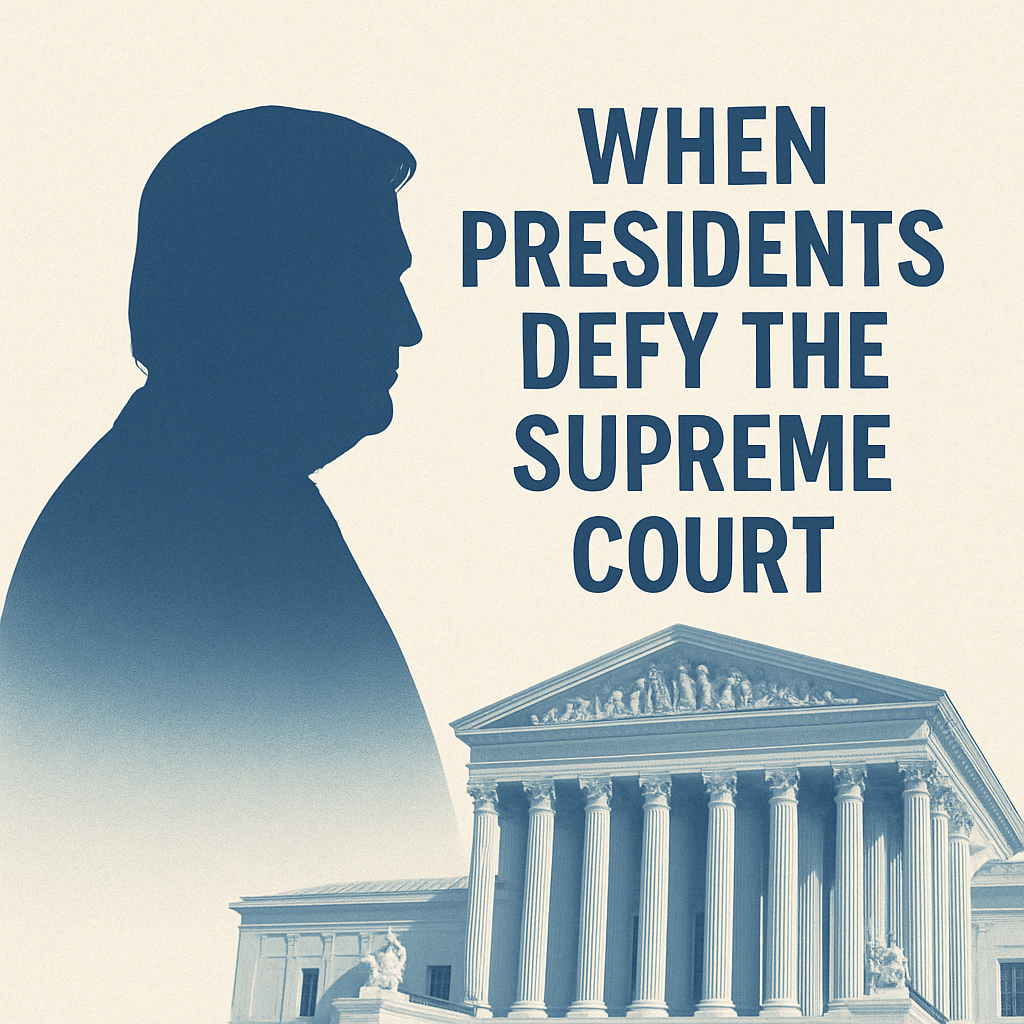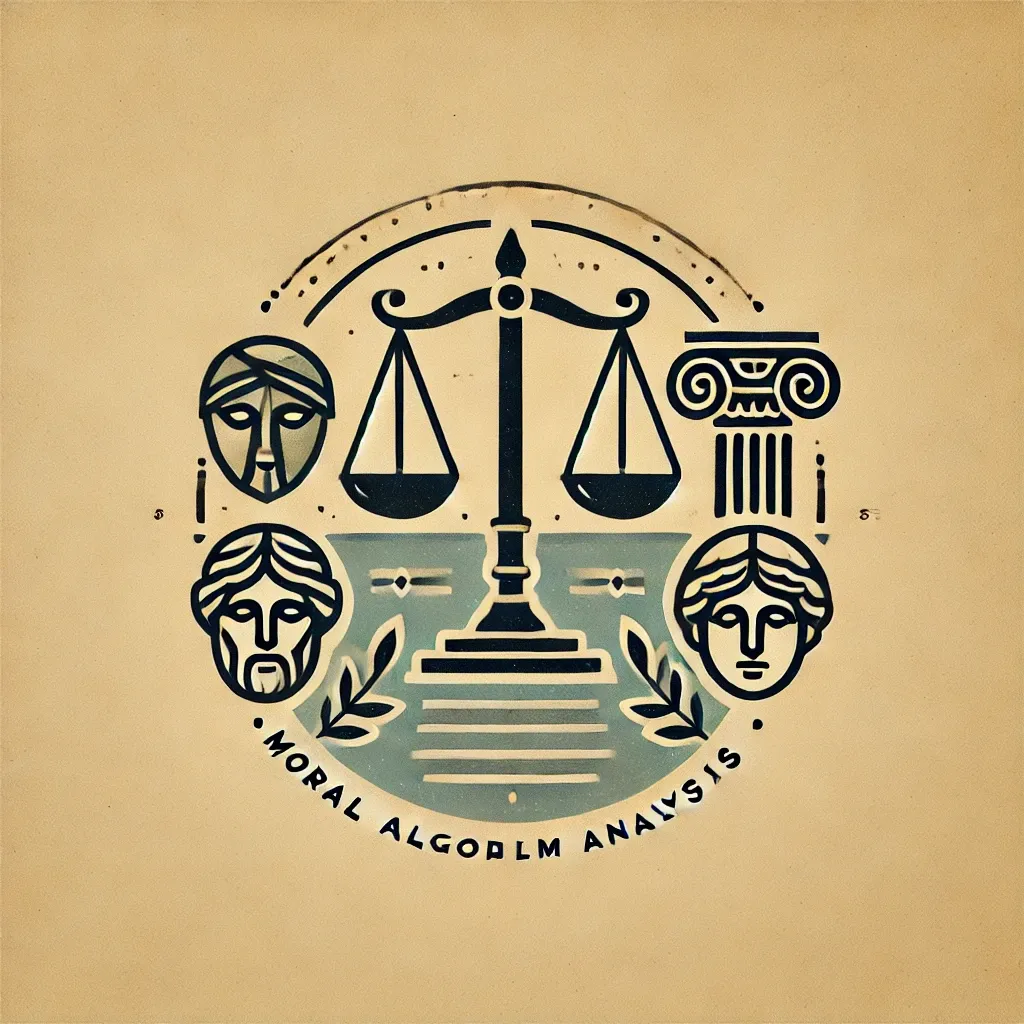When Power Refuses the Law: Presidential Defiance and the Ethics of Obedience
When Presidents defy the Supreme Court, democracy is tested. Explore five pivotal moments where power clashed with law—judged through the eyes of Adams, Rawls, and Aristotle.

In the American system of government, the separation of powers is not just a legal principle—it’s a moral safeguard. When Presidents defy Supreme Court rulings, the republic is tested: will law prevail, or will power bend it? This conversation explores five pivotal moments in U.S. history where the Executive branch either directly challenged or ignored the authority of the Judiciary. Through a rigorous ethical lens—John Adams' Moral Algorithm, John Rawls' Veil of Ignorance, and Aristotle's Virtue Ethics—we examine not only what happened, but what should have happened. Each case becomes more than a legal clash; it becomes a test of the soul of the republic.
1. Andrew Jackson & Worcester v. Georgia (1832)
Incident Recap
- Supreme Court Decision: The Court ruled that Georgia had no jurisdiction over Cherokee lands, affirming the sovereignty of Native American nations.
- Presidential Response: President Jackson ignored this ruling, and the state continued policies that led to the Trail of Tears—the forced removal of the Cherokee, resulting in great human suffering.
Ethical Analysis
- John Adams’ Moral Algorithm:
Common Good vs. Private Power
Jackson’s actions clearly undermined the common good. Instead of protecting the rights and well-being of an entire community, his defiance served the expansionist ambitions and interests of white settlers. It did not support the collective flourishing of all people, but rather privileged a particular group. - John Rawls’ Veil of Ignorance:
Rule Agreement Without Knowing Your Position
Under the veil, no one would agree to a rule that permits one part of the population to be forcibly displaced based solely on ethnicity. The injustice inherent in targeting a specific group would be unacceptable if one did not know whether they might belong to that group. - Aristotle’s Virtue Ethics:
Building Virtue, Justice, and Human Flourishing
Jackson’s defiance did not encourage virtues such as justice, temperance, or prudence. It led to a failure to honor human dignity and did not promote a flourishing society. Rather, it set a precedent for governance driven by prejudice and expediency.
2. Abraham Lincoln & Ex parte Merryman (1861)
Incident Recap
- Supreme Court Decision: Chief Justice Taney ruled that Lincoln’s suspension of habeas corpus without Congressional approval was unconstitutional.
- Presidential Response: Lincoln chose to disregard this ruling, maintaining the suspension during the Civil War on the grounds of preserving the Union and national security.
Ethical Analysis
- John Adams’ Moral Algorithm:
Common Good vs. Private Power
Lincoln’s decision, though in defiance of a legal ruling, was justified in his view by the necessity to safeguard the union and, by extension, the common good. However, critics might contend that it shifted power toward the executive for political ends rather than strictly serving a universal public interest. - John Rawls’ Veil of Ignorance:
Rule Agreement Without Knowing Your Position
Behind the veil, one might hesitate to agree to a rule that permits suspension of fundamental rights—even temporarily—since anyone might find themselves vulnerable. The uncertainty about one’s status in a time of national crisis makes such a rule deeply contentious. - Aristotle’s Virtue Ethics:
Building Virtue, Justice, and Human Flourishing
While Lincoln’s choice was aimed at preserving the nation in an existential crisis, the action risks eroding the standard of law and justice. Although the intent was to secure a greater good, bypassing judicial oversight does not ideally cultivate a virtue-based political culture.
3. Franklin D. Roosevelt & Humphrey's Executor v. United States (1935)
Incident Recap
- Supreme Court Decision: The Court ruled that the President could not remove a commissioner of an independent regulatory agency (the FTC in this case) without cause, thereby limiting executive power over independent institutions.
- Presidential Response: Prior to the decision, Roosevelt had removed a commissioner—a move that the ruling retrospectively called into question, highlighting tension between presidential authority and judicial oversight.
Ethical Analysis
- John Adams’ Moral Algorithm:
Common Good vs. Private Power
Roosevelt’s removal of the commissioner is viewed as a maneuver to strengthen executive control for political ends. Such actions may have served his administration's objectives rather than a disinterested appeal to the common good, potentially consolidating power and sidelining independent oversight. - John Rawls’ Veil of Ignorance:
Rule Agreement Without Knowing Your Position
Under the veil, individuals would likely reject a rule permitting arbitrary removal of officials, as it would create an environment of uncertainty and instability. Nobody would favor a system where government positions are subject solely to the whims of a single leader. - Aristotle’s Virtue Ethics:
Building Virtue, Justice, and Human Flourishing
The action could be seen as corrosive to the virtues of fairness and accountability. It undermines the independent checks that safeguard justice and, thereby, risks impairing the conditions needed for genuine human flourishing in a democratic society.
4. Harry S. Truman & Youngstown Sheet & Tube Co. v. Sawyer (1952)
Incident Recap
- Supreme Court Decision: The Court ruled that President Truman did not have the authority to seize private property (steel mills) during the Korean War without explicit Congressional authorization.
- Presidential Response: Though Truman initially ordered the seizure as a measure of national security, he ultimately complied with the Court’s decision and returned control to the private owners.
Ethical Analysis
- John Adams’ Moral Algorithm:
Common Good vs. Private Power
Truman’s initial act of seizing the mills might have been justified as an effort to secure national stability during wartime. Yet, it also risked subordinating individual property rights and the independence of private enterprise to executive power. His later compliance, however, restored a balance more consistent with serving the common good over unilateral power. - John Rawls’ Veil of Ignorance:
Rule Agreement Without Knowing Your Position
From behind the veil, a rule that allows the executive to seize property arbitrarily would likely be rejected due to the high cost to individual liberty and economic security. The uncertainty of being on the losing end of such a seizure would make the rule unacceptable to rational individuals. - Aristotle’s Virtue Ethics:
Building Virtue, Justice, and Human Flourishing
The initial overreach did little to foster virtues of moderation and justice. However, Truman’s eventual deference to judicial authority can be seen as a corrective measure—an acknowledgment that restraint and respect for legal limits are essential for a just society and the flourishing of its citizens.
5. Donald Trump & the Kilmar Abrego Garcia Case (2025)
Incident Recap
- Supreme Court Decision: The Court ordered the Trump administration to take steps to facilitate the return of Kilmar Abrego Garcia, a Salvadoran national who had been wrongfully deported.
- Presidential Response: The administration defied the ruling, prompting discussions about potential contempt proceedings and broader constitutional implications.
Ethical Analysis
- John Adams’ Moral Algorithm:
Common Good vs. Private Power
In this case, the defiance of a clear judicial directive appears to prioritize political expediency or ideological goals over the common good. By rejecting the court’s order, the administration risked undermining the rule of law and the impartial protection of individual rights. - John Rawls’ Veil of Ignorance:
Rule Agreement Without Knowing Your Position
When considering a rule that permits an executive branch to ignore court orders—even when an individual’s rights are at stake—rational individuals behind the veil would likely reject it. The uncertainty of who might be deprived of fair treatment makes such a rule profoundly unstable and unjust. - Aristotle’s Virtue Ethics:
Building Virtue, Justice, and Human Flourishing
Defying a Supreme Court decision in this manner fails to cultivate the virtues of justice, respect, and civic responsibility. Such an act erodes trust in governmental institutions and does little to promote the common conditions necessary for human flourishing. Respect for law and institutional integrity is essential for a virtuous community.
Final Summary
Each incident reveals the tension between executive action and judicial authority—a dynamic central to the U.S. constitutional framework. Applying these three ethical frameworks underscores key insights:
- John Adams’ Moral Algorithm:
The common good is best served by restraint, respect for law, and the avoidance of power being used solely for private or partisan ends. - John Rawls’ Veil of Ignorance:
Rational individuals would generally reject rules permitting unchecked executive power because they risk arbitrary harm to any individual when roles are unknown. - Aristotle’s Virtue Ethics:
True virtue in governance builds justice and communal flourishing; actions that erode accountability and the rule of law hinder the development of a virtuous society.
These ethical examinations help underline why adherence to judicial decisions—and by extension, the rule of law—is fundamental to maintaining a government that serves all its citizens fairly.

